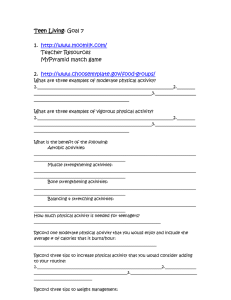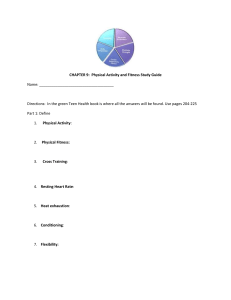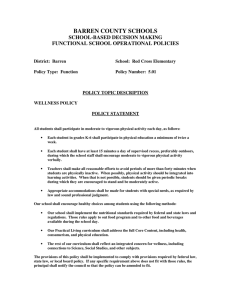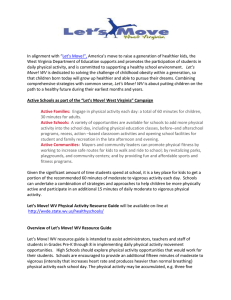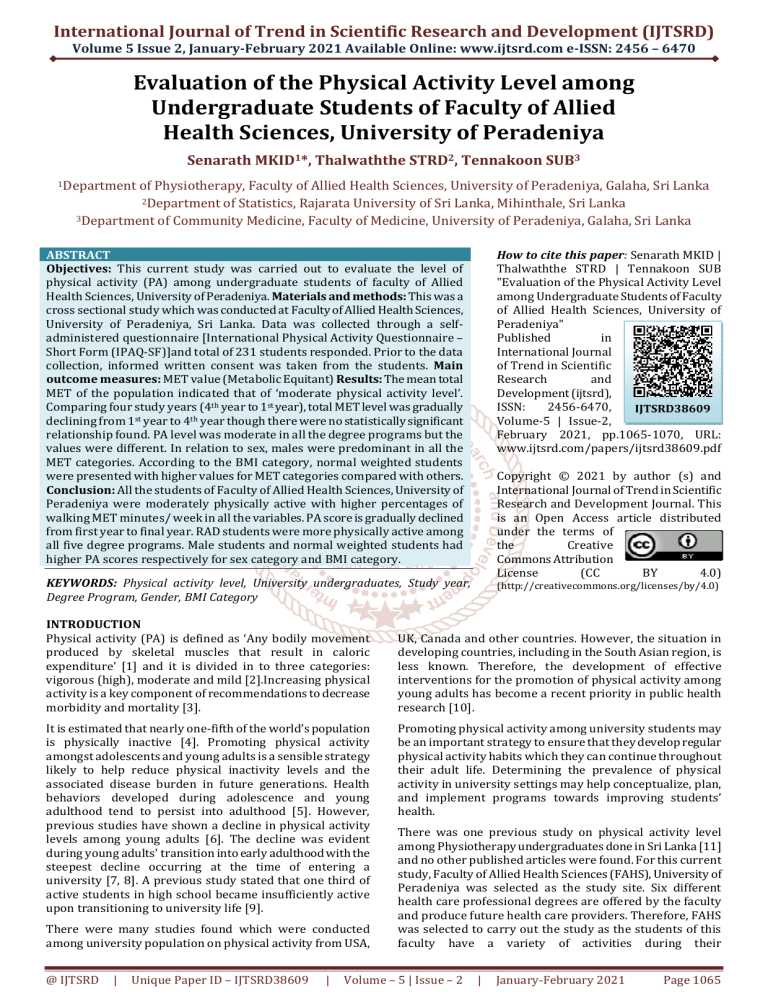
International Journal of Trend in Scientific Research and Development (IJTSRD)
Volume 5 Issue 2, January-February 2021 Available Online: www.ijtsrd.com e-ISSN: 2456 – 6470
Evaluation of the Physical Activity Level among
Undergraduate Students of Faculty of Allied
Health Sciences, University of Peradeniya
Senarath MKID1*, Thalwaththe STRD2, Tennakoon SUB3
1Department
of Physiotherapy, Faculty of Allied Health Sciences, University of Peradeniya, Galaha, Sri Lanka
2Department of Statistics, Rajarata University of Sri Lanka, Mihinthale, Sri Lanka
3Department of Community Medicine, Faculty of Medicine, University of Peradeniya, Galaha, Sri Lanka
ABSTRACT
Objectives: This current study was carried out to evaluate the level of
physical activity (PA) among undergraduate students of faculty of Allied
Health Sciences, University of Peradeniya. Materials and methods: This was a
cross sectional study which was conducted at Faculty of Allied Health Sciences,
University of Peradeniya, Sri Lanka. Data was collected through a selfadministered questionnaire [International Physical Activity Questionnaire –
Short Form (IPAQ-SF)]and total of 231 students responded. Prior to the data
collection, informed written consent was taken from the students. Main
outcome measures: MET value (Metabolic Equitant) Results: The mean total
MET of the population indicated that of ‘moderate physical activity level’.
Comparing four study years (4th year to 1st year), total MET level was gradually
declining from 1st year to 4th year though there were no statistically significant
relationship found. PA level was moderate in all the degree programs but the
values were different. In relation to sex, males were predominant in all the
MET categories. According to the BMI category, normal weighted students
were presented with higher values for MET categories compared with others.
Conclusion: All the students of Faculty of Allied Health Sciences, University of
Peradeniya were moderately physically active with higher percentages of
walking MET minutes/ week in all the variables. PA score is gradually declined
from first year to final year. RAD students were more physically active among
all five degree programs. Male students and normal weighted students had
higher PA scores respectively for sex category and BMI category.
How to cite this paper: Senarath MKID |
Thalwaththe STRD | Tennakoon SUB
"Evaluation of the Physical Activity Level
among Undergraduate Students of Faculty
of Allied Health Sciences, University of
Peradeniya"
Published
in
International Journal
of Trend in Scientific
Research
and
Development (ijtsrd),
ISSN:
2456-6470,
IJTSRD38609
Volume-5 | Issue-2,
February 2021, pp.1065-1070, URL:
www.ijtsrd.com/papers/ijtsrd38609.pdf
KEYWORDS: Physical activity level, University undergraduates, Study year,
Degree Program, Gender, BMI Category
(http://creativecommons.org/licenses/by/4.0)
INTRODUCTION
Physical activity (PA) is defined as ‘Any bodily movement
produced by skeletal muscles that result in caloric
expenditure’ [1] and it is divided in to three categories:
vigorous (high), moderate and mild [2].Increasing physical
activity is a key component of recommendations to decrease
morbidity and mortality [3].
It is estimated that nearly one-fifth of the world’s population
is physically inactive [4]. Promoting physical activity
amongst adolescents and young adults is a sensible strategy
likely to help reduce physical inactivity levels and the
associated disease burden in future generations. Health
behaviors developed during adolescence and young
adulthood tend to persist into adulthood [5]. However,
previous studies have shown a decline in physical activity
levels among young adults [6]. The decline was evident
during young adults' transition into early adulthood with the
steepest decline occurring at the time of entering a
university [7, 8]. A previous study stated that one third of
active students in high school became insufficiently active
upon transitioning to university life [9].
There were many studies found which were conducted
among university population on physical activity from USA,
@ IJTSRD
|
Unique Paper ID – IJTSRD38609
|
Copyright © 2021 by author (s) and
International Journal of Trend in Scientific
Research and Development Journal. This
is an Open Access article distributed
under the terms of
the
Creative
Commons Attribution
License
(CC
BY
4.0)
UK, Canada and other countries. However, the situation in
developing countries, including in the South Asian region, is
less known. Therefore, the development of effective
interventions for the promotion of physical activity among
young adults has become a recent priority in public health
research [10].
Promoting physical activity among university students may
be an important strategy to ensure that they develop regular
physical activity habits which they can continue throughout
their adult life. Determining the prevalence of physical
activity in university settings may help conceptualize, plan,
and implement programs towards improving students’
health.
There was one previous study on physical activity level
among Physiotherapy undergraduates done in Sri Lanka [11]
and no other published articles were found. For this current
study, Faculty of Allied Health Sciences (FAHS), University of
Peradeniya was selected as the study site. Six different
health care professional degrees are offered by the faculty
and produce future health care providers. Therefore, FAHS
was selected to carry out the study as the students of this
faculty have a variety of activities during their
Volume – 5 | Issue – 2
|
January-February 2021
Page 1065
International Journal of Trend in Scientific Research and Development (IJTSRD) @ www.ijtsrd.com eISSN: 2456-6470
undergraduate life such as lectures, practical, clinical
placement, field visits, extracurricular activities etc. and it
may have a correlation with their physical activity level.
Materials and methods
For this questionnaire based cross-sectional study, Six
hundred and fifty three (653) registered students were
taken as the study population and calculated study sample
was 243. Students who were presented with recent
fractures, any injuries, long-term illnesses like asthma etc.
were excluded. Study year (Batch - 4th year, 3rd year, 2nd year,
1st year), degree program (Medical Laboratory Sciences-MLS,
Pharmacy-PCY,
Physiotherapy-PHY,
Radiography/
Radiotherapy-RAD, Nursing-NUR), sex (male, female) and
body mass index – BMI category (underweight, normal
weight, pre-obesity, obesity class I, obesity class II, obesity
class III) were taken as the independent variables.
The International Physical Activity Questionnaire – short
form (IPAQ - SF) was taken as the study instrument. It
consisted of seven items, asking participants to report on the
duration of time they have spent doing the following
activities over last week: walking, moderate activity,
vigorous activity and sitting. The reliability and validity of
the questionnaire were first tested across 12 countries (14
sites) in 2000. The findings suggest that it has acceptable
properties for use in many settings and in different
languages, and is suitable for national population-based
prevalence studies of participation in physical activity [12,
13].Computation of the total score required summation of
the duration (in minutes) and frequency (days) of walking,
moderate-intensity and vigorous-intensity activities. IPAQ
scoring features categorical and continuous scoring. All
continuous scores were expressed in MET (Metabolic
Equivalent) – minutes/ week. [14].In this current study,
MET-minutes/week values were calculated according to the
independent variables and used to categorize the physical
activity level as mild, moderate and high.
Informed written consent was obtained from the students
who were willing to participate in this study. Only 231
answered questionnaires were collected giving a rate of
participation of 95%. Students were in the age range of 21 to
35 years and consisted of both girls and boys (83 males35.9%, 148 females-64.1%). Study sample consisted of 574th (final) year, 54-3rd year, 55-2nd year and 65-1st year
students. They were; 37-MLS, 37-PCY, 46-PHY, 54-RAD, 57NUR students. Among the total sample of the students
according to BMI categories, it was identified that 43underweight, 151-normal weight, 19-pre-obese, 2-obesity
class I and 2-obesity class II students. In the analysis,
confidence level was set to 95% in all the tests. Therefore,
statistical significant level was taken as 5% (p<0.05) to
identify statistically significant difference between
means/proportions of the variables.
Mean value for different MET categories (total MET, vigorous
MET, moderate MET and walking MET) were calculated.
Analysis of variance (ANOVA) and post – hoc tests were used
to determine whether there were any statistically significant
differences between the means strata for the independent
variables of study level, degree program and BMI category as
they had more than two variables in each group.
Independent sample t-test was used for independent
variable of sex as it has two variables, male and female.
Results
According to the analysis of the total sample of students, the
means of the MET minutes/ week values reported as
@ IJTSRD
|
Unique Paper ID – IJTSRD38609
|
vigorous MET of 347.9, moderate MET of 143.6, walking
MET of 1186.8 and total MET of 1678.3 MET minutes/ week.
The walking MET was comparably higher than the vigorous
and moderate MET among all independent variables. As the
total MET value was in-between the range of 600 – 3000
MET minutes/ week, it can be stated as the students of
Faculty of Allied Health Sciences were ‘Moderate physically
active students’.
Study year
Among the mean MET values, the highest vigorous MET of
566.7 minutes/ week showed by 3rd year students and
highest moderate MET of 178.9 minutes/ week was
recorded by 2nd year students. The highest walking MET of
1895.9 minutes/ week and the highest total MET of 2201.8
minutes/ week was observed among 1st year students.
According to the statistical analysis by SPSS 22.0 software
conducted with ANOVA and post-hoc test, there was no
statistically significant difference found between group
means of MET minute/ week values in different study years
(Table 1).
Degree program
Physiotherapy undergraduates have shown the highest
vigorous MET of 681.7 minutes/ week and the highest
moderate MET of 221.3 minutes/ week. Radiography/
Radiotherapy undergraduate students have presented with
the highest walking MET of 2232.4 minutes/ week and
highest total MET of 2667.2 minutes/ week. According to the
statistical analysis that was conducted with ANOVA and
post-hoc test, there was no statistically significant difference
found between group means of MET minute/ week values in
different degree programs (Table 2).
Sex
Among all three MET minutes/ week categories and total
MET, males were identified with all highest values of MET
categories (vigorous, moderate, walking and total MET)
compared with females. Independent sample t-test was used
to find any statistically significant difference between sex
and different MET categories, but there was no any
difference has found (Table 3).
BMI category
Among mean MET values, highest vigorous MET of 401.9
minutes/ week, highest walking MET of 1345.4 minutes/
week and highest total MET of 1868.0 minutes/ week has
shown by normal weighted students. Students of obesity
class II has identified with the highest moderate MET of
720.0 minutes/ week. According to the statistical analysis
that was conducted with ANOVA and post-hoc test, there was
no statistically significant difference found between group
means of MET minute/ week values in different BMI
categories (Table 4).
Discussion
In this study, the means of the MET minutes/ week values
were consisted as vigorous MET of 347.9, moderate MET of
143.6, walking MET of 1186.8 and total MET of 1678.3 MET
minutes/ week. The total MET minutes/ week value was
taken for the calculation of the physical activity level. As the
total MET value of this study lies in between 600-3000 MET
minutes/ week, the students of the Faculty of Allied Health
Sciences were identified as ‘Moderate physically active
students’ according to the results obtained. There were
previous studies found with the same results among
university students from India in 2017 [15] and Malaysia in
2015 [16]. Opposing the results of the current study, some
Volume – 5 | Issue – 2
|
January-February 2021
Page 1066
International Journal of Trend in Scientific Research and Development (IJTSRD) @ www.ijtsrd.com eISSN: 2456-6470
previous studies concluded that the university students were
highly physically active [17-19] in some researches and
having low physical activity level in some other studies [20,
11].
Comparing four study years (4th year to 1st year), total MET
level was gradually declining from 1st year to 4th year though
there were no statistically significant relationship found.
First year students were presented with high PA compared
with final year students; may be because final year students
have tight clinical schedule with less extracurricular
activities and first year students have more opportunities to
engage with more sports and extracurricular activities. A
similar cross sectional study conducted among nursing
students has shown that both the freshman and seniors were
identified as irregular active and were considered as risk
groups. But it also stated that seniors were more active
compared with freshmen. [21]
Five Allied Health degree programs were included in this
study; Medical Laboratory Sciences (MLS), Pharmacy (PCY),
Physiotherapy (PHY), Radiography/ Radiotherapy (RAD)
and Nursing (NUR). In the current study, Physical activity
level was moderate in all the degree programs but the values
were different. RAD students had the highest value in
moderate physical activity level as 2667.2 MET minutes/
week. Next was PHY students presented with 1641.6 MET
value, almost 1000 MET minutes/ week less than RAD
students. It was expected to have highest value of PA level
with PHY students, because they have more knowledge on
physical activities, physical fitness, sedentary life styles and
nutrition. But RAD students had the highest score among all
of them, may be due to their engagement with other
extracurricular activities compared with other students. PCY
students had 1591.4 and MLS and NUR students were
presented with almost same values, respectively 1173.7 and
1154.9 MET minutes/ week. It may be due to more
laboratory work and practical work, they may have to stand
for long time along the day, therefore they may not find
enough time for other extracurricular activities due to the
tiredness felt at the end of the day. Nevertheless, there was
no statistically significant relationship found in this study.
There were no previously conducted studies were found for
MLS or RAD degree programs. A study conducted among
nursing undergraduates concluded that both seniors and
juniors were physically inactive [21] which was not
supporting the results of this study. There were numerous
research articles found based on physiotherapy students.
Most of those studies concluded that the physiotherapy
students were highly physically active compared with other
students [16, 22-24] which is not supporting the current
study results. Another previous Sri Lankan study which was
done in 2016 among physiotherapy students, concluded that
they had low physical activity level [11] which also not
supporting the current results. Another similar study was
found in the health and biology fields including pharmacy
students. It was reported that biology and physical education
students were more active compared to biochemistry
students and pharmacy students were moderately physically
active; supporting the current study results [14].
In relation to sex, males were predominant in all the MET
categories and have a total MET of 2093.3 minutes/ week. A
study done in 2018 with undergraduate students of the
University of Tuzla [90] has illustrated total MET of 4619.4
@ IJTSRD
|
Unique Paper ID – IJTSRD38609
|
and 6013.5 MET minutes/ week for males which was
comparably higher than females. They were identified as
‘highly physically active students’ while the current study
identified their students as ‘moderately physically active
students’. Almost all the previous studies were concluded
that males were more physically active compared with
females irrespective of their physical activity level, whether
it is mild, moderate or high. It may be because their body
composition, physical fitness level, endurance level and
strength levels were comparably higher in males than
females. In the current study, normal weighted students
were presented with higher values for MET categories
compared with others and this result was supported by a
study done in Malaysia in 2015 among university students
[16].
A study conducted among medical students found that if the
students had social support from friends and families they
were tend to be more physically active [25]. There were few
barriers were identified to achieve recommended physical
activity level by previous studies; time limitation, lack of
accessible and lack of suitable sporting places [19], social
influence and lack of willpower [26], study related activities
and overtime shifts of medical students [25], low family
income, mental health and self-efficacy [27]. Another study
found that students were more active during weekdays
compared with weekend days [28]. The residence of the
students may have an influence on their physical activity
level, a study concluded that hostel resident students have
low PA levels [15]. Students who were more physically
active or with high physical activity level shown high levels
of academic performances [29] and decreased sedentary
behaviors [30]. Even though students had high level
knowledge on physical activity they were not physically
active highly, presenting there were no correlation between
the knowledge of PA and students’ PA level [18]. In the
current study, there were no statistically significant
difference found in any variable; study year, degree program,
sex and BMI category.
Conclusion
As the conclusion, all the students of Faculty of Allied Health
Sciences, University of Peradeniya were moderately
physically active with higher percentages of walking MET
minutes/ week in all the variables. PA score is gradually
declined from first year to final year. RAD students were
more physically active among all five degree programs. Male
students and normal weighted students had higher PA
scores respectively for sex category and BMI category.
Acknowledgement
I would like to express my gratitude to Prof. Sampath U.B.
Tennakoon for the guidance throughout this research and
Mr. S.T.R.D. Thalwaththe and Ms. D.A.R.K. Dasanayaka for
their contribution in data analysis.
Furthermore I would like to thank the head and the
academic staff of department of Physiotherapy, Faculty of
Allied Health Sciences, University of Peradeniya for their
immense support given throughout this work.
*Ethical approval was taken from the Ethics Review
Committee, Faculty of Allied Health Sciences, University
of Peradeniya.
*No funds were granted for this study.
*There are no conflict of interest.
Volume – 5 | Issue – 2
|
January-February 2021
Page 1067
International Journal of Trend in Scientific Research and Development (IJTSRD) @ www.ijtsrd.com eISSN: 2456-6470
Tables
Table 1: Mean and significance probability of different study years from ANOVA and post-hoc tests for PA
ANOVA Post hoc tests
4th year
3rd year
2nd year 1st year Mean
4th year
0.786
0.996
0.921
231.4
rd year
3
0.786
0.894
0.387
566.7
Vigorous
0.464
2nd year
0.996
0.894
0.827
379.6
MET
1st year
0.921
0.387
0.827
162.5
Total mean
347.9
4th year
0.692
0.998
0.989
166.7
rd year
3
0.692
0.598
0.847
85.3
Moderate
0.606
nd year
2
0.998
0.598
0.962
178.9
MET
1st year
0.989
0.847
0.962
143.4
p-values of
Total
mean
143.6
MET minutes/
4th year
0.984
0.903
0.236
678.5
week
rd year
3
0.984
0.989
0.445
920.2
Walking
0.257
2nd year
0.903
0.989
0.650
1137.3
MET
1st year
0.236
0.445
0.650
1895.8
Total mean
1186.8
0.954
0.902
0.500
1166.6
4th year
3rd year
0.954
0.999
0.834
1570.4
0.571
Total MET
2nd year
0.902
0.999
0.905
1695.8
1st year
0.500
0.834
0.905
2201.8
Total mean
1678.3
Table 2: Mean and significance probability of different degree programs from ANOVA and post-hoc tests for PA
ANOVA Post hoc tests
MLS
PCY
PHY
RAD
NUR
Mean
MLS
0.943 0.499 0.995 1.000 194.6
PCY
0.943
0.929 0.993 0.868 436.8
0.349
PHY
0.499 0.929
0.670 0.304 681.7
Vigorous MET
RAD
0.995 0.993 0.670
0.974 312.6
NUR
1.000 0.868 0.304 0.974
153.8
Total mean
347.9
MLS
0.552 0.225 0.855 0.679
37.3
PCY
0.552
0.987 0.966 0.997 177.6
0.308
PHY
0.225 0.987
0.727 0.886 221.3
Moderate MET
RAD
0.855 0.966 0.727
0.997 122.2
NUR
0.679 0.997 0.886 0.997
148.1
143.6
Total mean
p-values of MET
minutes/ week
.432 1.000 941.8
MLS
1.000 .999
PCY
1.00
.998
.461 1.000 977.1
PHY
.999
.998
.223 1.000 738.5
0.185
Walking MET
RAD
.432
.461
.223
.246 2232.4
NUR
1.000 1.000 1.000 .246
853.0
Total mean
1186.8
MLS
0.992 0.985 0.421 1.000 1173.7
PCY
0.992
1.000 0.727 0.986 1591.4
0.318
PHY
0.985 1.000
0.716 0.974 1641.6
Total MET
RAD
0.421 0.727 0.716
0.288 2667.2
NUR
1.000 0.986 0.974 0.288
1154.9
Total mean
1678.3
Table 3: Mean and significance probability of sex from independent sample t-test for PA
Mean value
Levene’s Independent sample
test
t-test (2-tailed)
Male Female Total
assumed
0.027
Vigorous
Equal
615.9
197.6
347.9
0.000
MET
variances not assumed
0.078
assumed
0.117
Moderate
Equal
198.4
112.9
143.6
0.004
MET
variances not assumed
0.182
assumed
0.769
Walking
Equal
1278.9 1135.1 1186.8
0.539
MET
variances not assumed
0.797
assumed
0.246
Equal
Total MET 2093.3 1445.5 1678.3
0.132
variances not assumed
0.306
P–
values of
MET
minutes/
week
@ IJTSRD
|
Unique Paper ID – IJTSRD38609
|
Volume – 5 | Issue – 2
|
January-February 2021
Page 1068
International Journal of Trend in Scientific Research and Development (IJTSRD) @ www.ijtsrd.com eISSN: 2456-6470
Table 4: Mean and significance probability of different BMI categories from ANOVA and post-hoc tests for PA
Under
Normal
PreObesity
Obesity
ANOVA Post hoc tests
Mean
weight
weight
obesity
class I
class II
Under weight
0.959
0.994
1.000
0.999
232.6
Normal weight
0.959
1.000
0.999
0.995
401.9
0.955
Pre- obesity
0.994
1.000
0.999
0.996
395.8
Vigorous
MET
Obesity class I
1.000
0.999
0.999
1.000
120.0
Obesity class II
0.999
0.995
0.996
1.000
0.0
Total mean
361.5
Under weight
.700
1.000
1.000
.419
211.1
Normal weight
.700
.890
.998
.238
120.6
0.193
Pre- obesity
1.000
.890
1.000
.449
211.6
Moderate
MET
Obesity class I
1.000
.998
1.000
.721
210.0
Obesity
class
II
.419
.238
.449
.721
720.0
p-values
Total mean
152.9
of MET
minutes/
Under weight
0.983
0.997
1.000
1.000
1002.1
week
Normal weight
0.983
0.937
1.000
1.000
1345.4
0.940
Pre- obesity
0.997
0.937
1.000
1.000
649.1
Walking
MET
Obesity class I
1.000
1.000
1.000
1.000
1.000
1039.5
Obesity class II
1.000
1.000
1.000
1.000
1.000
1138.5
Total mean
1211.7
Under weight
0.978
1.000
1.000
1.000
1445.8
Normal weight
0.978
0.976
1.000
1.000
1868.0
Pre- obesity
1.000
0.976
1.000
1.000
1256.5
0.961
Total
MET
Obesity class I
1.000
1.000
1.000
1.000
1.000
1369.5
Obesity class II
1.000
1.000
1.000
1.000
1.000
1858.5
Total mean
1726.1
References
[1] Caspersen C, Powell K, Christenson G. Physical
activity, exercise and physical fitness: definitions and
distinctions for health-related research. Public Health
Reports1985; 100:126–135.
[2]
Godin G, Shephard RJ. Godin Leisure-Time Exercise
Questionnaire. Medicine and Science in Sports and
Exercise1997; S36-S38.
[3]
Haskell WL, Lee IM, Pate RR, Powell KE, Blair SN,
Franklin BA. Physical activity and public health:
Updated recommendation for adults from the
American College of Sports Medicine and the
American Heart Association. Med Sci Sports
Exerc2007; 39:1423–1434.
[4]
Dumith SC, Hallal PC, Reis RS, Kohl 3rd HW.
Worldwide prevalence of physical inactivity and its
association with human development index in 76
countries. Prev Med2011; 53 (1–2):24–28.
[5]
Telama R, Yang X, Viikari J, Välimäki I, Wanne O,
Raitakari O. Physical activity from childhood to
adulthood. Am J Prev Med2005; 28 (3):267–273.
[6]
[7]
[8]
Van Mechellen W, Twisk J, Post G, Snel J, Kemper H.
Physical activity of young people: the Amsterdam
Longitudinal Growth and Health Study. Med Sci Sports
Exerc2000; 32 (9):1610–1616.
Kwan MY, Cairney J, Faulkner GE, Pullenavegum EE.
Physical activity and other health-risk behaviours
during the transition into adulthood: A longitudinal
cohort study. American Journal of Preventive
Medicine2012;
42
(1):14-20.
doi:10.1016/j.amepre.2011.08.026
Sigmundova D, Chmelik F, Sigmund E, Feltlova D,
Fromel K. Physical activity in the lifestyle of Czech
@ IJTSRD
|
Unique Paper ID – IJTSRD38609
|
university
students:
Meeting
health
recommendations. European Journal of Sport
Science2013;
13
(6):
744-750.
doi:10.1080/17461.2013.776638
[9]
Bray SR, Born HA. Transition to university and
vigorous physical activity: Implications for health and
phychological well-being. Journal of American College
Health2004;
52
(4):
181-188.
doi:10.3200/JACH.52.4.181-188.
[10]
De Meester F, van Lenthe FJ, Spittaels H, Lien N, De
Bourdeaudhuij I. Interventions for promoting
physical activity among European teenagers: a
systematic review. Int J BehavNutrPhys Act. 2009; 6
(1):1–11.
[11]
Ranasinghe C, Sigera C, Ranasinghe P, Jayawardena R,
Ranasinghe ACR, Hills AP et al. Physical inactivity
among physiotherapy undergraduates: exploring the
knowledge-practice gap. BMC Sport Science2016;
8:39. Doi: 10.1186/s13102-016-0063-8
[12]
Craig CL, Marshall AL, Sjöström M, Bauman AE, Booth
ML, Ainsworth BE et al. International physical activity
questionnaire: 12-country reliability and validity.
Med Sci Sports Exerc. 2003; 35 (8):1381–1395.
Pubmed: PMID:12900694
[13]
IPAQ Research Committee. Guidelines for data
processing and analysis of the international physical
activity questionnaire (IPAQ)—short and long forms.
Stockholm: KarolinskaInstitutet2005.
[14]
Da Silva GDSF, Bergama chine R, Rosa M, Melo C,
Miranda R, Filho MB. Evaluation of the physical
activity level of under graduation students of health/
biology fields. Rev Bras Med Esporte2007; 13 (1).
Volume – 5 | Issue – 2
|
January-February 2021
Page 1069
International Journal of Trend in Scientific Research and Development (IJTSRD) @ www.ijtsrd.com eISSN: 2456-6470
[15]
[16]
Singh H, Singh S. Prevalence, patterns and associated
factors of physical activity in Indian university
students. Euro J of physical education and sports
science2017; 3 (10). doi:10.5281/zenodo.886613
Rajappan R, SelvaganapathyK, Liew L. physical
activity level among university students: a cross
sectional survey. Int J Physiother Res2015; 3 (6):
1336-1343. DOI: 10.16965/ijpr.2015. 202
[17]
Fagaras SP, Radu LE, Vanvu G. The level of physical
activity of university students. Procedia - Social and
Behavioral Sciences2015; 197: 1454-1457.
[18]
Ward T. Student knowledge of physical activity on
campus. Oklahoma AHPERD2014; 51 (2).
[19]
El-Gilany AH, Badawi K, El-Khawaga G, Awadalla N.
Physical activity profile of students in Mansoura
University, Egypt. Eastern Mediterranean Health
Journal2011; 17 (8).
[20]
Sultoni K et al. IOP Conf. Ser.: Mater. Sci. Eng. 2017;
180, 012212
[21]
Pires CGS, Mussi FC, De Cerqueiria BB, Pitanga FJG, Da
Silva DO. Physical activity practice among
undergraduate
students
in
nursing.
Actapaulenferm2013; 26 (5).
[22]
[23]
SklempeKI, Znika M, Brumnic V. Physical activity,
health-related quality of life and musculoskeletal pain
among students of physiotherapy and social sciences
in Eastern Croatia – Cross-sectional survey. Ann Agric
Environ
Med.
2019;
26
(1):
182–190.
doi:10.26444/aaem/102723
Da˛browska-Galas M, Plinta R, Da˛browska J,
Skrzypulec-Plinta V. Physical activity in students of
@ IJTSRD
|
Unique Paper ID – IJTSRD38609
|
the Medical University of Silesia in Poland. PhysTher.
2013; 93: 384–392.
[24]
Asma MB, Gencer YG. Assessing University students’
physical activity levels in terms of different variables.
International Journal of Progressive Education2019;
15 (2). doi:10.29329/ijpe.2019.189.1
[25]
Wattanapisit A, Fungthongcharoen K, Saengow U et al.
Physical activity among medical students in Southern
Thailand: a mixed methods study. BMJ Open2016; 6:
e013479. doi:10.1136/ bmjopen-2016-013479
[26]
Jajatet al. IOP Conf. Ser.: Mater. Sci. Eng. 2017;
180:012210
[27]
Mohammed G, Md Said S, Azuhairi A, Ariffin. Physical
inactivity and its associated factors among university
students. IOSR Journal of Dental and Medical
Sciences2014; 13 (10): 119-130.
[28]
Clemente FM, Nikolaidis PT, Martins FML, Mendes RS.
Physical Activity Patterns in University Students: Do
They Follow the Public Health Guidelines? PLoS
ONE2016; 11 (3):e0152516.
[29]
Chung Q-E, Abdulrahman SA, Khan MKJ, Sathik HBJ,
Rashid A. The relationship between levels of physical
activity and academic achievement among Medical
and Health Sciences students at Cyberjaya University
College of Medical Sciences. Malays J Med Sci. 2018;
25 (5):88–102.
[30]
Deliens T, Deforche B, Bourdeaudhuij ID, Clarys P.
Determinants of Physical activity and sedentary
behavior in university students: a qualitative study
using focus group discussions. BMC Public Health
2015; 15: 201. Doi: 10.1186/s12889-015-1553-4
Volume – 5 | Issue – 2
|
January-February 2021
Page 1070

